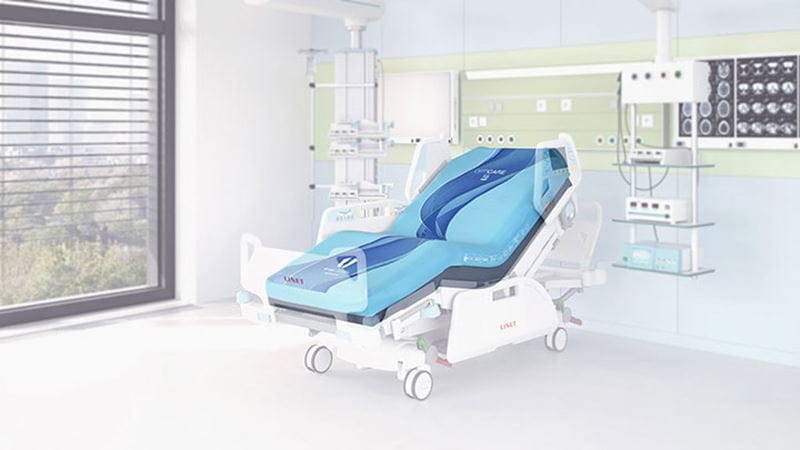Resting protectively

A bed is probably thought to be the most basic item in terms of patient care. However, this is far from the truth. Its construction and the textile that covers it can contribute to how long patients remain in the hospital and how comfortable they are during their stay.
“Hospital mattresses have to be waterproof,” says Richard Haxby, Technical Director within Trelleborg Coated Systems. Richard Haxby previously worked for Dartex Coatings, a company Trelleborg acquired in 2018. Its polyurethane-coated fabrics are the recognized choice for support surface fabrics.
“Gone are the heavy PVC-covered mattresses that were commonly used in the past. Polyurethane-coated fabrics are the recognized choice for support surface fabrics. Behind today’s mattress technology is the desire to create a bed that can contribute to a patient’s welfare and recovery. In particular, the driving factor is to suppress the development of avoidable pressure ulcers.”
Pressure ulcers, also known as pressure sores or bedsores, are injuries to the skin and underlying tissue, caused primarily by prolonged pressure on the skin. They usually affect people confined to a bed or those who sit in a chair or wheelchair for long periods of time. These ulcers are a huge problem globally. In the US, up to USD 11.6 billion is spent annually on treatment, and each pressure ulcer adds more than USD 48,000 in costs to a hospital stay. There is a lack of data on potential savings, but a recent study by the Organisation for Economic Co-operation and Development found that the cost of treating pressure ulcers is substantially higher than the cost of prevention.
A healthcare mattress must be both breathable and durable, which is why polyurethane is the best choice for medical applications. Breathability is important to keep a patient cool and comfortable. Durability is vital to avoid cracks and puncture or strikethrough. These can allow fluid ingress through to the inside of the mattress.
In addition, fabrics must be resistant to stringent cleaning regimes that use damaging bleaches, which can cause cracking and degradation of the mattress
cover if not properly used.
“The dilemma we have in engineering a mattress textile is to achieve a balance between breathability and durability. The more durable a covering, the less breathable it is, and vice versa,” says Haxby.
Working in partnership with hospital mattress manufacturers is essential to optimize the performance of a bed. “It’s key to understand the use of the mattress. Different primary uses will determine the textile design in relation to the mattress and what the balance needs to be between breathability and durability.
“For instance, with a mattress used in a burns unit, where a patient would have exuding wounds, breathability would be the priority to keep the skin cool and dry — while for a mattress for community use, where it’s likely to be moved frequently from bed to bed and perhaps handled robustly, durability becomes important.”
The inner core of the mattress will also have an influence on the covering. If it’s foam, gel or air, then the outer fabric needs to match the inside. The latest innovation in mattress core is noodle technology. Unlike traditional foam mattresses, this core is machine washable on the hospital site.
“The design of this mattress core is very clever, but the nature of the noodles originally meant that it failed key flame retardant tests,” Haxby says. “We solved this issue with the development of a cover that enabled the product to go to market. Like all furniture, mattresses must meet stringent fire resistance regulations. Our fabrics comply with Crib 5 and Crib 7 regulations in the UK and Europe, as well as CAL 117 for the US.”
Fabrics don’t just apply to beds — they’re also used for chairs, wheelchairs and pillows.
“Our latest developments are focused on hospital chairs,” Haxby says. “Moving a patient from a bed to a chair is done as early as possible to help patient mobility, even in acute wards. Chair fabrics, though, tend not to be so advanced, so we’re looking at how to bridge the gap between the high standards of bed materials and those of chairs. We also have the capability to produce graphics on our fabrics, such as printing manufacturer cleaning instructions and corporate imagery directly onto mattresses.”
For more information, please go to:
Engineered Coated Fabrics
This is an article has been reproduced from Trelleborg's T-Time magazine. To download the latest edition, go to: www.trelleborg.com/t-time
Press Service: This article is available in eight languages. Media are welcome to use this article in their own publications. To download the article and pictures in any language go to https://bamboo-contentpartner.com/. If you reproduce information from this release, please give contact details as: www.trelleborg.com.